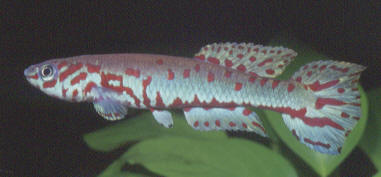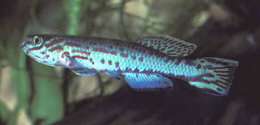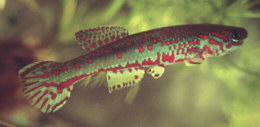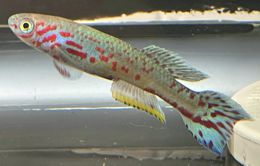Fundulopanchax ndianus (Scheel 1968)
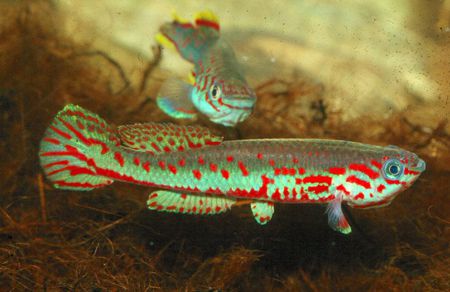
Fp.ndianus
(1975)
Photo courtesy of Tony Terceira
| Meaning of Name |
After the Ndian River. |
||||||||
| First Description |
Scheel J.J. 1968. (Aphyosemion ndianum). Rivulins of the Old World. TFH Publications: p 455-456, figures. |
||||||||
| Size |
7 cm |
||||||||
| Meristics |
|
||||||||
| Karyotype |
n = 20, A = 28 (Scheel 1968) |
||||||||
| Sub-Genus |
Paraphyosemion |
||||||||
| Group |
ndianus (has previously been placed in the gardneri group) |
||||||||
| Synonyms |
|
||||||||
Populations
|
Obudu - This population was collected by John Hughes in July 1973 with the Fp.gardneri population Obudu. Unfortunately all ndianus did not survive to start a captive breeding group. |
||||||||
| Type Locality |
Caught near Osombo, eastern Nigeria near the southern part of the Mamfe - Eyomojok - Calabar road. Also given as different locations in other references :-
|
||||||||
| Distribution |
South eastern border of Nigeria & neighbouring Cameroon. They were caught originally in the Akpa-Yafe Rver drainage area, eastern Nigeria. This area is 10 miles west of the Ndian River. These rivers are short & rise in the Oban Mountains, joining the Rio del Rey east of Calabar. |
||||||||
| Habitat |
Rainforest swamps & swampy areas of brooks. |
||||||||
| Distinguishing Characteristics | Red line on the bottom of the body between the caudal & anal fins. A similar line can also be seen on A.cameronense. ndianus however, has a more solid body & the caudal fin has a thick red band at the bottom marginal (sometimes sub-marginal) edge. The top edge has a thinner band. The caudal has (most often) thick red lines (sometimes only one) radiating through it. | ||||||||
| Colour/Pattern Variability | Low | ||||||||
| History |
Described by Scheel in Rivulins of the Old World in 1968. These original fish were caught by Clausen in February 1959. These were taken to Scheel in Denmark in 1959. These were bred but not distributed. They became lost in 1965. Schiötz also caught them in April 1959 & June 1965. All these collections were caught in various localities near Osomba which is on the southern part of the Calabar-Eyomojok-Mamfe road. In 1966 Scheel collected them in many localities east of the Ndian drainage from Mbonge west of Mt.Cameroon to Kribi. First mentioned in the BKA newsletter in No.98,
October 1973. A further report was contained in BKA newsletter 103. |
||||||||
| Breeding Notes |
I have had this species on two occasions. They were both a little more difficult laying well for a time & then nothing for months. I did find out a useful method in inducing them to spawn by keeping them cool (around 60-65°F). Eggs are layed in bottom mops or peat substrate. I didn't try sand at the time but I would think this could also be used. Eggs incubated in water take 3-5 weeks to hatch. Laying eggs on wet peat or dry incubation takes about 6-8 weeks. Fry are capable of taking newly hatched brine shrimp as a first food. Growth is quite fast with sexual maturity being attained around 6-8 weeks. The first breeding report in BKA newsletter No.98,
October 1973 concerned a then undistributed form of Aphyosemion
(later to identified as Fp.ndianus).
Eggs were taken out & put into a seperate container & allowed
to develop for 10-12 days. At this stage first signs of development
were observed. They were put into damp peat at a consistency wetter
than that used for true annuals. Another report by Fred Wright in the same newsletter
gave another account of experiences where he water incubated the eggs
for 25 days & had a 100% hatch rate. Fifteen eggs were used in this
experiment. No fungicide was added. Further to this article Fred Wright also put
a piece in BKA newsletter No.103, March 1974. He tried water incubation
at 72°F & found first hatching occurred after 25 days of incubation
with a complete hatching at 28 days. Some eggs were dry stored at 75°F
for 40 days but results were not too good. Longer periods were tried
in dry storage but this did not improve the hatch rate. It was found
the longer they were stored the harder they became to hatch. Ken Dosser in BKA newsletter No.207, November 1982 tried to breed them at pH 6·8, DH 5, temperature 72°F without success. He increased the temperature to 75°F, still without success. After inadvertantly leaving the fish house roof window open overnight resulting in a drop in temperature in the tank down to 66°F. This resulted in many eggs being laid in mops. He maintained the tank at 68°F afterwards with more success. |
||||||||
| Diameter of Egg | 1.3 mm | ||||||||
| Remarks |
A fish called Aphyosemion
'Korup 01' was caught in the Korup National Park in 1992 by André
Kamden Toham close to the Ndian River. Wildekamp 1995 regarded it as
being close to ndianus & called
it Fundulopanchax sp.aff.ndianus.This
fish had a 'stripey' appearance with 2 red lines horizontally through
the body & 2 horizontal lines on the anal fin, one at the margin,
the other in the centre of the fin. The dorsal fin also had 2 horizontal
lines, one on the outer margin, the other close to the body. |
